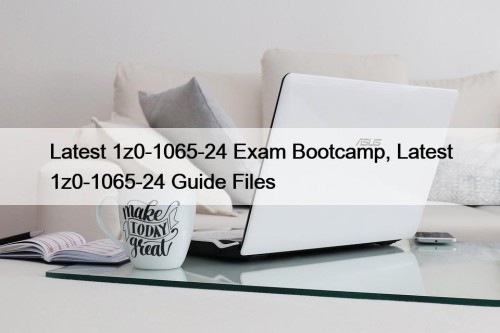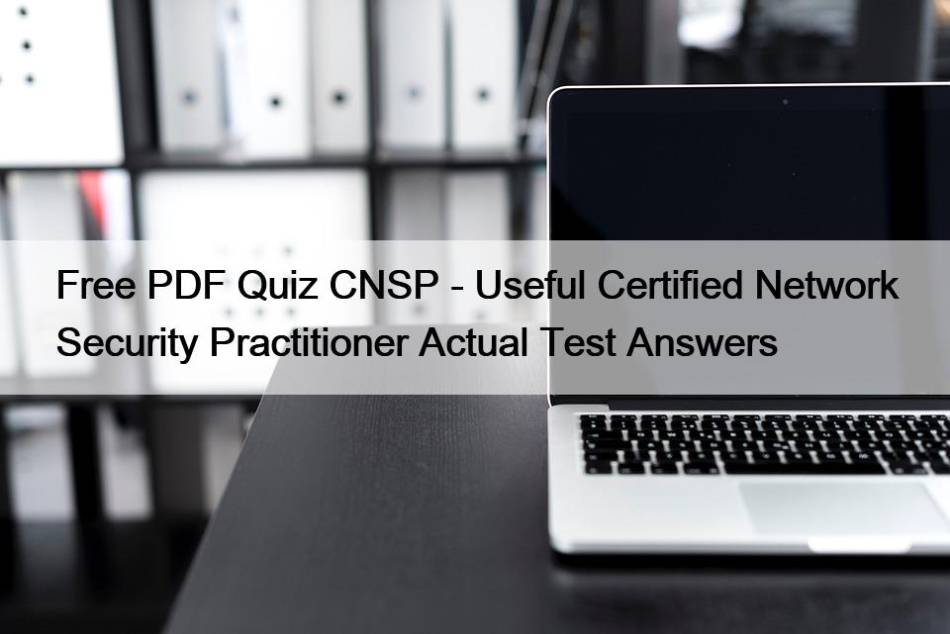Most Popular
 Trustable CIPS Guide L6M2 Torrent and the Best Accurate New L6M2 Exam Fee
Trustable CIPS Guide L6M2 Torrent and the Best Accurate New L6M2 Exam Fee
If you come to our website to choose our L6M2 ...
 Latest 1z0-1065-24 Exam Bootcamp, Latest 1z0-1065-24 Guide Files
Latest 1z0-1065-24 Exam Bootcamp, Latest 1z0-1065-24 Guide Files
With the pass rate is 98.65% for 1z0-1065-24 learning materials, ...
 Study Anywhere, Anytime With 1Z0-1057-23 PDF Dumps File
Study Anywhere, Anytime With 1Z0-1057-23 PDF Dumps File
If you are a workman and you want to pass ...



Free PDF Quiz CNSP - Useful Certified Network Security Practitioner Actual Test Answers

TestPassed's products can not only help you successfully pass The SecOps Group certification CNSP Exams, but also provide you a year of free online update service, which will deliver the latest product to customers at the first time to let them have a full preparation for the exam. If you fail the exam, we will give you a full refund.
The SecOps Group CNSP Exam Syllabus Topics:
| Topic | Details |
|---|---|
| Topic 1 |
|
| Topic 2 |
|
| Topic 3 |
|
| Topic 4 |
|
| Topic 5 |
|
| Topic 6 |
|
| Topic 7 |
|
| Topic 8 |
|
| Topic 9 |
|
| Topic 10 |
|
| Topic 11 |
|
| Topic 12 |
|
| Topic 13 |
|
| Topic 14 |
|
| Topic 15 |
|
| Topic 16 |
|
| Topic 17 |
|
| Topic 18 |
|
>> CNSP Actual Test Answers <<
Quiz The SecOps Group - CNSP - Trustable Certified Network Security Practitioner Actual Test Answers
With our CNSP exam materials, you will have more flexible learning time. With our CNSP practice prep, you can flexibly arrange your study time according to your own life. You don't need to be in a hurry to go to classes after work as the students who take part in a face-to-face class, and you also never have to disrupt your schedule for learning. Just use your computer, IPAD or phone, then you can study with our CNSP Practice Questions.
The SecOps Group Certified Network Security Practitioner Sample Questions (Q34-Q39):
NEW QUESTION # 34
Which one of the following is a phishing email?

- A. None of the above
- B. Both A and B
- C. Only A
- D. Only B
Answer: D
Explanation:
The screenshot shows an email labeled "B" with the subject "Verify your email address" purportedly from Apple. To determine if this is a phishing email, we need to analyze its content and characteristics against common phishing indicators as outlined in CNSP documentation. Since option A is not provided in the screenshot, we will evaluate email B and infer the context for A.
Analysis of Email B:
Sender and Branding: The email claims to be from "Apple Support" and includes an Apple logo, which is a common tactic to establish trust. However, phishing emails often impersonate legitimate brands like Apple to deceive users.
Subject and Content: The subject "Verify your email address" and the body requesting the user to verify their email by clicking a link ("Verify Your Email") are typical of phishing attempts. Legitimate companies like Apple may send verification emails, but the tone and context here raise suspicion.
Link Presence: The email contains a clickable link ("Verify Your Email") that is purportedly for email verification. The screenshot does not show the URL, but phishing emails often include malicious links that lead to fake login pages to steal credentials. CNSP emphasizes that unsolicited requests to click links for verification are a red flag.
Urgency and Vague Instructions: The email includes a statement, "If you did not make this change or believe an unauthorized person has accessed your account, click here to cancel and secure your account." This creates a sense of urgency, a common phishing tactic to prompt immediate action without critical thinking.
Generic Greeting: The email starts with "Dear User," a generic greeting often used in phishing emails. Legitimate companies like Apple typically personalize emails with the user's name.
Suspicious Elements: The email mentions "your Apple ID ([email protected])," which is a placeholder rather than a specific email address, further indicating a mass phishing campaign rather than a targeted, legitimate communication.
Phishing Indicators (per CNSP):
CNSP documentation on phishing identification lists several red flags:
Unsolicited requests for verification or account updates.
Generic greetings (e.g., "Dear User" instead of a personalized name).
Presence of links that may lead to malicious sites (not verifiable in the screenshot but implied).
Urgency or threats (e.g., "click here to cancel and secure your account").
Impersonation of trusted brands (e.g., Apple).
Email B exhibits multiple indicators: the generic greeting, unsolicited verification request, urgent call to action, and impersonation of Apple.
Option A Context:
Since the screenshot only shows email B, and the correct answer is "Only B," we can infer that email A (not shown) does not exhibit phishing characteristics. For example, A might be a legitimate email from Apple with proper personalization, no suspicious links, or a different context (e.g., a purchase confirmation rather than a verification request).
Evaluation of Options:
1. Only A: Incorrect, as email A is not shown, and the correct answer indicates B as the phishing email.
2. Only B: Correct. Email B shows clear phishing characteristics, such as impersonation, a generic greeting, an unsolicited verification link, and urgency, aligning with CNSP's phishing criteria.
3. Both A and B: Incorrect, as A is implied to be non-phishing based on the correct answer.
4. None of the above: Incorrect, as B is a phishing email.
Conclusion: Email B is a phishing email due to its impersonation of Apple, generic greeting, unsolicited verification request with a link, and use of urgency to prompt action. Since A is not shown but implied to be non-phishing, the correct answer is "Only B."
NEW QUESTION # 35
On a Microsoft Windows operating system, what does the following command do?
net localgroup Sales Sales_domain /add
- A. Add a domain group to the local group Sales
- B. Display the list of the users of a local group Sales
- C. Add a local group Sales to the domain group
- D. Add a new user to the local group Sales
Answer: A
Explanation:
The net localgroup command manages local group memberships on Windows systems, with syntax dictating its action.
Why B is correct: net localgroup Sales Sales_domain /add adds the domain group Sales_domain to the local group Sales, granting its members local group privileges. CNSP covers this for privilege escalation testing.
Why other options are incorrect:
A: Displaying users requires net localgroup Sales without /add.
C: Adding a user requires a username, not a group name like Sales_domain.
D: The reverse (local to domain) uses net group, not net localgroup.
NEW QUESTION # 36
Which Kerberos ticket is required to generate a Silver Ticket?
- A. Session Ticket
- B. There is no specific ticket required for generating a Silver Ticket
- C. Ticket-Granting Ticket
- D. Service Account Ticket
Answer: D
Explanation:
A Silver Ticket is a forged Kerberos Service Ticket (TGS - Ticket Granting Service) in Active Directory, granting access to a specific service (e.g., MSSQL, CIFS) without KDC interaction. Unlike a Golden Ticket (TGT forgery), it requires:
Service Account's NTLM Hash: The target service's account (e.g., MSSQLSvc) hash, not a ticket.
Forgery: Tools like Mimikatz craft the TGS (e.g., kerberos::golden /service:<spn> /user:<user> /ntlm:<hash>).
Kerberos Flow (RFC 4120):
TGT (Ticket-Granting Ticket): Obtained via AS (Authentication Service) with user creds.
TGS: Requested from TGS (Ticket Granting Service) using TGT for service access.
Silver Ticket Process:
No TGT needed; the attacker mimics the TGS step using the service account's stolen hash (e.g., from a compromised host).
C . Service Account Ticket: Misnomer-it's the hash of the service account (e.g., MSSQLSvc) that enables forgery, not a pre-existing ticket. CNSP's phrasing likely tests this nuance.
Security Implications: Silver Tickets are stealthier than Golden Tickets (service-specific, shorter-lived). CNSP likely stresses hash protection (e.g., LAPS) and Kerberos monitoring.
Why other options are incorrect:
A . Session Ticket: Not a Kerberos term; confuses session keys.
B . TGT: Used for Golden Tickets, not Silver.
D: Incorrect; the service account's hash (implied by "ticket") is essential.
Real-World Context: Silver Tickets exploited in APT29 attacks (2020 SolarWinds) for lateral movement.
NEW QUESTION # 37
Which of the following statements regarding Authorization and Authentication is true?
- A. Authentication includes the execution rules that determine what functionality and data the user can access. Authentication and Authorization are both the same thing.
- B. Authentication is the process where requests to access a particular resource are granted or denied. Authorization is providing and validating identity.
- C. Authentication controls which processes a person can use and which files they can access, read, or modify. Authentication and authorization typically do not operate together, thus making it impossible to determine who is accessing the information.
- D. Authorization is the process where requests to access a particular resource are granted or denied. Authentication is providing and validating the identity.
Answer: D
Explanation:
Authentication and Authorization (often abbreviated as AuthN and AuthZ) are foundational pillars of access control in network security:
Authentication (AuthN): Verifies "who you are" by validating credentials against a trusted source. Examples include passwords, MFA (multi-factor authentication), certificates, or biometrics. It ensures the entity (user, device) is legitimate, typically via protocols like Kerberos or LDAP.
Authorization (AuthZ): Determines "what you can do" after authentication, enforcing policies on resource access (e.g., read/write permissions, API calls). It relies on mechanisms like Access Control Lists (ACLs), Role-Based Access Control (RBAC), or Attribute-Based Access Control (ABAC).
Option A correctly separates these roles:
Authorization governs access decisions (e.g., "Can user X read file Y?").
Authentication establishes identity (e.g., "Is this user X?").
In practice, these processes are sequential: AuthN precedes AuthZ. For example, logging into a VPN authenticates your identity (e.g., via username/password), then authorizes your access to specific subnets based on your role. CNSP likely stresses this distinction for designing secure systems, as conflating them risks privilege escalation or identity spoofing vulnerabilities.
Why other options are incorrect:
B: Reverses the definitions-Authentication doesn't grant/deny access (that's AuthZ), and Authorization doesn't validate identity (that's AuthN). This mix-up could lead to flawed security models.
C: Falsely equates AuthN and AuthZ and attributes access rules to AuthN. They're distinct processes; treating them as identical undermines granular control (e.g., NIST SP 800-53 separates IA-2 for AuthN and AC-3 for AuthZ).
D: Misassigns access control to AuthN and claims they don't interoperate, which is false-they work together in every modern system (e.g., SSO with RBAC). This would render auditing impossible, contradicting security best practices.
Real-World Context: A web server (e.g., Apache) authenticates via HTTP Basic Auth, then authorizes via .htaccess rules-two separate steps.
NEW QUESTION # 38
What is the response from a closed UDP port which is not behind a firewall?
- A. A RST packet
- B. None of the above
- C. No response
- D. ICMP message showing Destination Unreachable
Answer: D
Explanation:
UDP is a connectionless protocol, and its behavior when a packet reaches a port depends on whether the port is open or closed. Without a firewall altering the response, the standard protocol applies.
Why A is correct: When a UDP packet is sent to a closed port, the host typically responds with an ICMP Type 3 (Destination Unreachable), Code 3 (Port Unreachable) message, indicating no service is listening. CNSP notes this as a key indicator in port scanning.
Why other options are incorrect:
B: RST packets are TCP-specific, not used in UDP.
C: No response occurs for open UDP ports unless an application replies, not closed ports.
D: A is correct, so "none of the above" is invalid.
NEW QUESTION # 39
......
Our The SecOps Group CNSP PDF dumps format has actual CNSP questions which are printable and portable. Hence, you can go through these The SecOps Group CNSP questions via your smart devices like smartphones, laptops, and tablets. The Certified Network Security Practitioner (CNSP) dumps PDF file can be used from any location and at any time. Furthermore, you can take print of The SecOps Group Questions PDF to do an off-screen study.
CNSP Free Sample: https://www.testpassed.com/CNSP-still-valid-exam.html
- Professional CNSP Actual Test Answers Spend Your Little Time and Energy to Clear The SecOps Group CNSP exam 🐤 Search for ➥ CNSP 🡄 and easily obtain a free download on 《 www.itcerttest.com 》 🎏New CNSP Test Answers
- New CNSP Test Answers 📊 Real CNSP Dumps Free 🍉 CNSP Latest Test Online 🟤 Download ➡ CNSP ️⬅️ for free by simply entering [ www.pdfvce.com ] website 🌠CNSP Trustworthy Exam Content
- Certified Network Security Practitioner latest study torrent - CNSP advanced testing engine - Certified Network Security Practitioner valid exam dumps 👄 Open ➠ www.real4dumps.com 🠰 enter ➠ CNSP 🠰 and obtain a free download 🛬CNSP Valid Exam Tutorial
- CNSP Latest Test Online 🏚 Exam CNSP Tutorial 😾 CNSP Latest Test Online 🚠 Search for ⏩ CNSP ⏪ and easily obtain a free download on ☀ www.pdfvce.com ️☀️ 🎲Books CNSP PDF
- CNSP Exam Questions 📀 CNSP Online Training Materials 🎢 Valid Braindumps CNSP Free 📘 Copy URL ▛ www.pass4leader.com ▟ open and search for ➽ CNSP 🢪 to download for free 🧉Reliable CNSP Test Book
- New CNSP Test Answers 🕒 CNSP Latest Test Online 🐫 CNSP Valid Test Discount 🧊 Search for ⏩ CNSP ⏪ and download it for free on ➠ www.pdfvce.com 🠰 website 🔛Books CNSP PDF
- Real CNSP Dumps Free 🎎 Valid Braindumps CNSP Free 🍑 CNSP Latest Exam Review 🥿 Simply search for { CNSP } for free download on ( www.examsreviews.com ) 🦮CNSP Online Training Materials
- Exam CNSP Tutorial 🦪 CNSP Online Training Materials 🧊 CNSP Test King 🏭 Easily obtain ⏩ CNSP ⏪ for free download through ➠ www.pdfvce.com 🠰 🧥CNSP Test King
- TOP CNSP Actual Test Answers - Valid The SecOps Group Certified Network Security Practitioner - CNSP Free Sample ⚛ Download ➥ CNSP 🡄 for free by simply searching on ▶ www.exams4collection.com ◀ 🛃Exam CNSP Tutorial
- 2025 CNSP: Certified Network Security Practitioner –Professional Actual Test Answers ❤️ Search on ➠ www.pdfvce.com 🠰 for 【 CNSP 】 to obtain exam materials for free download 🍵Real CNSP Dumps Free
- 2025 CNSP: Certified Network Security Practitioner –Professional Actual Test Answers 🤐 Search for ( CNSP ) on ▷ www.exam4pdf.com ◁ immediately to obtain a free download 🔨CNSP Online Training Materials
- CNSP Exam Questions
- mufeed.uz cognischool.net www.weitongquan.com wheelwell.efundisha.co.za 911marketing.tech ow-va.com 144.48.143.207 patersontemple.com tutorial.mentork.in iiconworld.com
Tags: CNSP Actual Test Answers, CNSP Free Sample, CNSP Study Reference, CNSP Latest Test Fee, Verified CNSP Answers